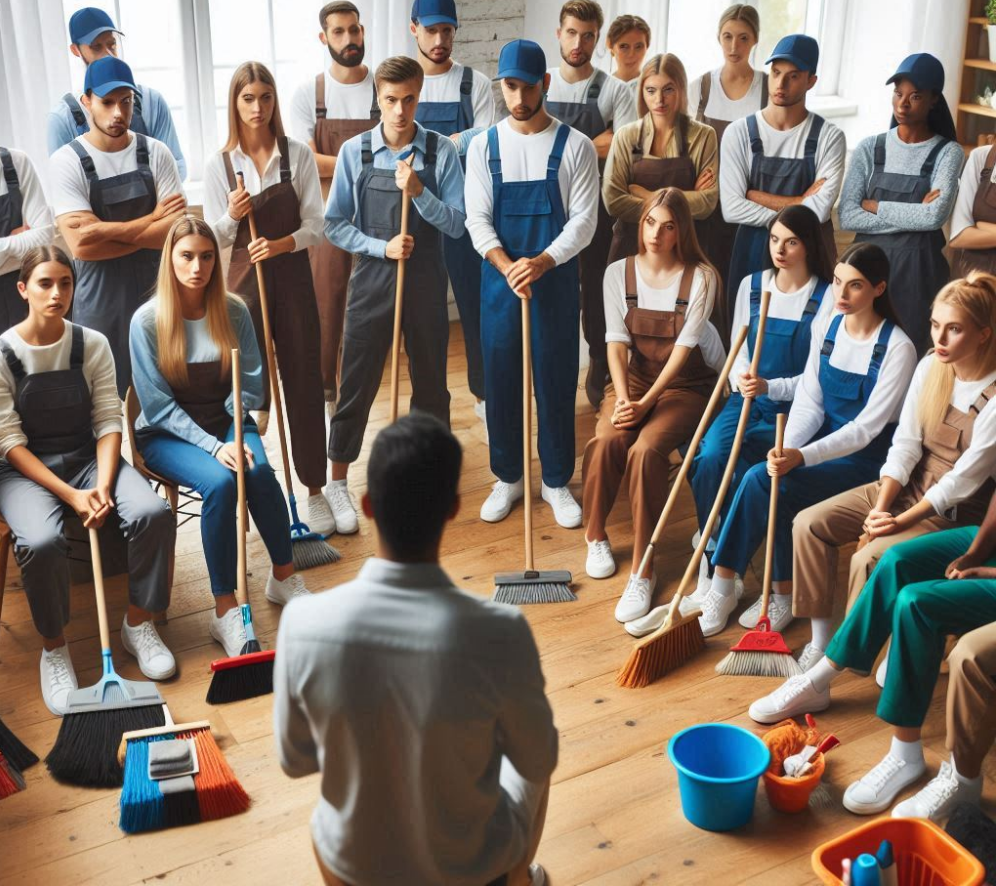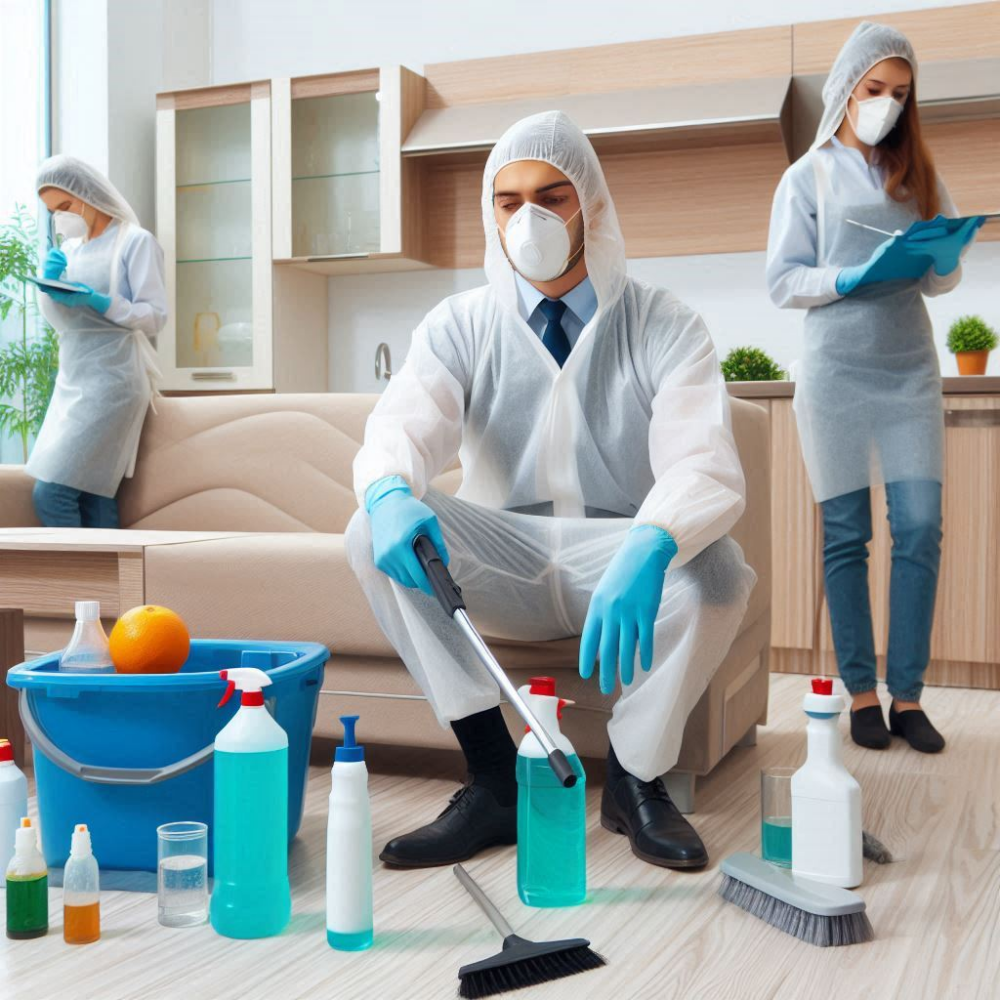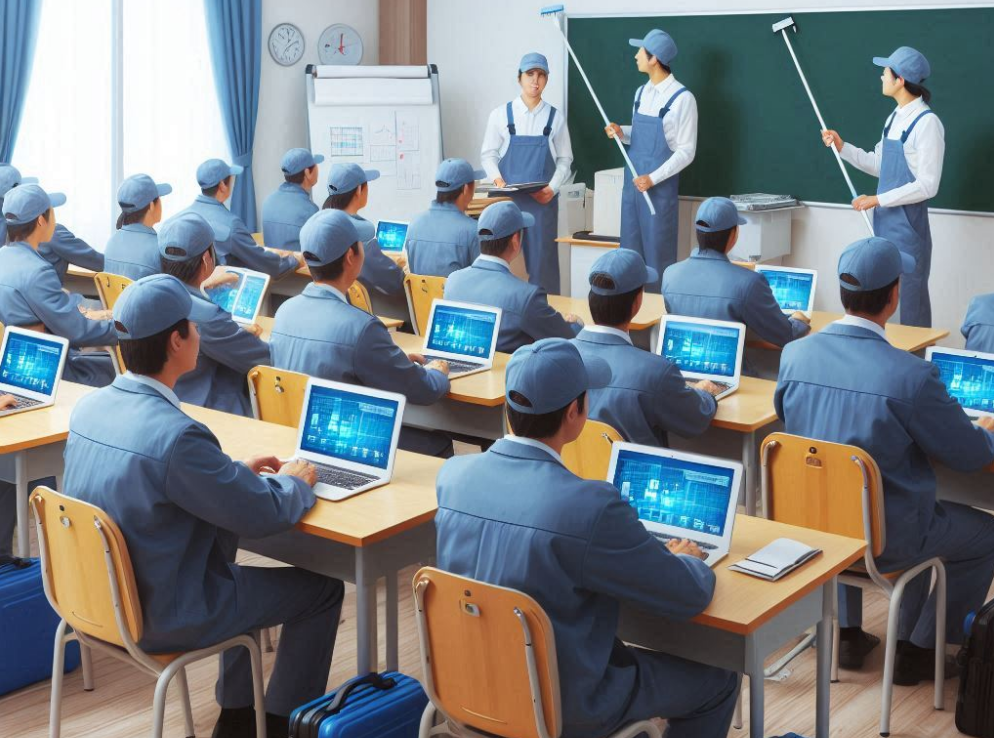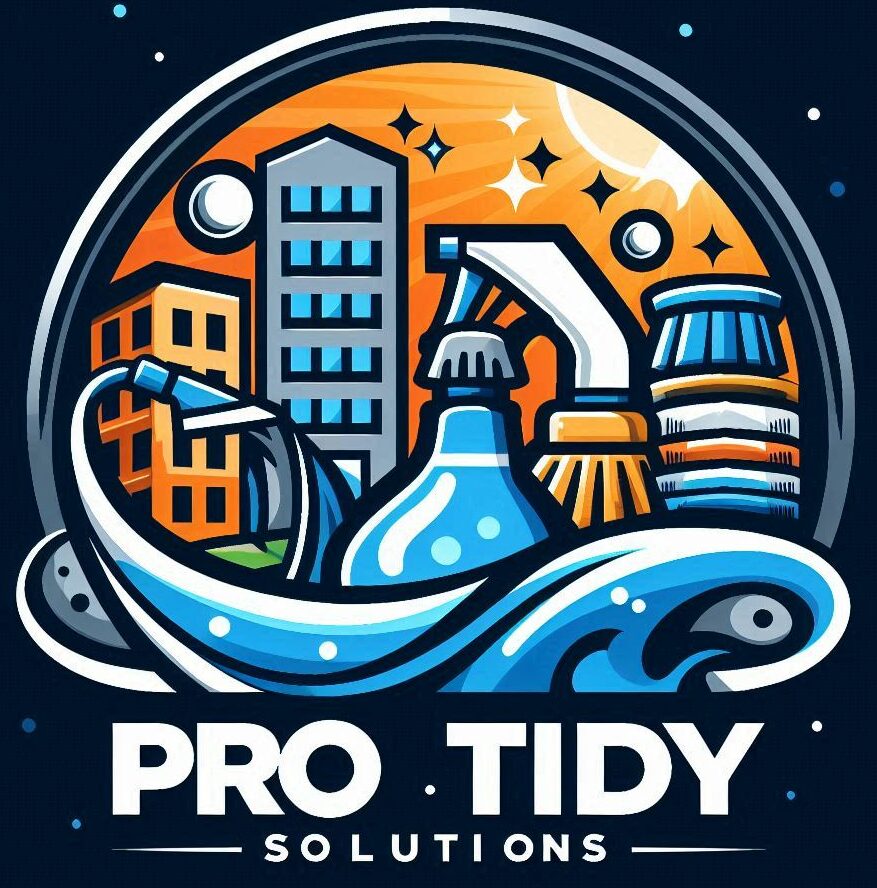
Investing in training for commercial cleaning staff is more than just a requirement; it’s crucial for a successful business. Good training ensures safety, boosts efficiency, makes sure you’re sticking to rules, and keeps clients happy.
Proper training builds confidence among employees, which means they can do their jobs better and safer. When workers understand their tasks well, they can clean spaces more efficiently, using the right methods and products, leading to better results and happier clients.
Safety is also a big part of this. Well-trained staff know how to avoid accidents and handle materials safely, reducing the risk of injuries and health issues. It’s about creating a safe work environment for everyone involved.
Staying on top of compliance is non-negotiable. Industry standards and regulations are constantly evolving, and trained staff ensure your business remains compliant and avoids potential penalties. Meeting these standards also reassures clients that they’re in good hands.
This guide aims to break down how you can achieve all this through effective training. From understanding what the cleaning protocols involve to why sticking to industry standards is important, we’ll cover the essentials for building a solid training foundation.
Understanding Commercial Cleaning Protocols
Cleaning protocols are the backbone of any commercial cleaning operation. They outline the specific procedures and guidelines that ensure effective and efficient cleaning. These protocols encompass various tasks like sanitation, disinfection, waste management, and more specialized cleaning activities. Each of these areas requires distinct knowledge and techniques to maintain a high standard of cleanliness and safety.
Sanitation and disinfection are critical components of cleaning protocols. While sanitation focuses on reducing the number of germs to a safe level, disinfection kills germs on surfaces. It’s essential to know the difference and apply each process correctly to maintain hygiene standards. This not only protects the health of those in the cleaned environment but also upholds the reputation of your business.
Waste management is another crucial aspect. Proper disposal methods and understanding how to handle hazardous waste are vital for preventing contamination and following legal regulations. Specialized cleaning includes tasks like handling biohazards or cleaning equipment that needs specific care, and knowing these nuances can set your team apart in the industry.
Adhering to industry standards and regulations isn’t just about compliance; it ensures the safety of both your team and your clients. These standards provide a benchmark for quality and safety in cleaning services. When teams conform to these standards, it boosts credibility and trust with clients, setting a business apart from those that might cut corners. Recognizing and understanding these protocols is key to training staff effectively and running a successful cleaning operation.
Core Components of a Comprehensive Training Program
Putting together a robust training program is essential for any commercial cleaning business aiming for long-term success. It’s all about equipping your staff with the right knowledge and skills to perform their duties effectively.
Understanding the different cleaning products and their specific uses is a starting point. Not all cleaning agents are created equal, and knowing which product to use on various surfaces can prevent damage and ensure efficiency. It’s crucial to educate staff on identifying the correct agents for the tasks they perform every day.
Proper cleaning techniques go hand-in-hand with product knowledge. This includes everything from surface-specific methods to using equipment correctly. Mastering these skills ensures that cleaning is thorough and reduces the wear and tear on both equipment and surfaces, ultimately saving on costs.

Health and safety cannot be overlooked. Staff must be well-versed in the use of Personal Protective Equipment (PPE) to protect themselves during tasks. Introducing ergonomic practices helps in preventing work-related injuries, ensuring that the team stays healthy and capable. In addition, training on how to handle spills, biohazards, and emergency situations is vital for safety and quick response.
Compliance with standards like OSHA ensures that your business stays out of trouble and remains reputable. This involves understanding regulatory requirements and maintaining documentation and records properly. Some clients may have their own compliance needs, which should be integrated into the training.
Developing a comprehensive training program that focuses on these core components not only enhances the skill set of your team but also reinforces the reliability and safety of your cleaning services.
Innovative Methods for Training Delivery
Exploring effective training delivery methods is as crucial as the training content itself. The approach taken can greatly influence the effectiveness of the training program and the engagement of the staff involved.

Traditional classroom-style training provides a structured environment, allowing for comprehensive coverage of topics and facilitated discussions. However, it’s essential to balance this with practical, on-the-job instruction, which can bridge the gap between theory and practice. Hands-on experience is invaluable, enabling staff to apply what they’ve learned in real-world settings.
Interactive methods such as hands-on demonstrations and role-playing scenarios can significantly boost engagement. These techniques help in reinforcing learning and allow trainees to experience realistic cleaning situations. This approach not only improves retention but also builds confidence, as staff feel more prepared for the tasks they’ll face.
Incorporating digital tools like e-learning platforms and training videos adds another layer of flexibility and accessibility. These resources can be particularly effective for ongoing training, allowing staff to learn at their own pace and revisit materials as needed. Digital platforms can deliver consistent information and support global or geographically dispersed teams, ensuring everyone is on the same page.
By integrating these innovative training methods, you cater to diverse learning preferences and make the training experience more comprehensive and impactful. This approach not only prepares your team effectively but also enhances the overall quality of cleaning services delivered.


Hello,
This is such a well-structured and informative post! It highlights the importance of training in commercial cleaning while breaking down the steps in a way that is easy to understand. I especially appreciate the focus on safety, compliance and innovative training methods.
It shows a forward-thinking approach. The inclusion of practical examples like using PPE and handling biohazards adds depth, making it clear how essential proper training is for both staff and client satisfaction.
Thank you for sharing this post.
Hello,
Thank you for your thoughtful feedback! I’m delighted to hear that you found the post well-structured and informative. It’s great to know that the emphasis on safety, compliance, and innovative training methods resonated with you.
We strive to provide valuable insights and practical examples to highlight the importance of proper training in commercial cleaning. Your appreciation of the forward-thinking approach and the inclusion of practical examples like using PPE and handling biohazards is truly encouraging.
Thank you for taking the time to share your thoughts!
Best regards,
Jay
Great post, Jay! You’ve highlighted the real backbone of a successful cleaning business: a well-trained team. I love how you broke down the importance of safety, compliance, and using the right techniques—it’s not just about cleaning but doing it smartly and responsibly. The emphasis on interactive and digital training is spot-on; staff learn best when they can see and practice real-world scenarios. It’s also great to see a focus on morale and professionalism—it’s a win for both the team and clients. Looking forward to more insights from you. What’s your favorite training tool for keeping things engaging?
Hi Naresh,
Thank you so much for your kind words! I’m thrilled to hear that you found the post insightful and that the emphasis on safety, compliance, and effective techniques resonated with you. Interactive and digital training truly make a difference in how staff learn and apply their skills.
As for my favorite training tool, I really enjoy using simulation-based training programs. They provide a hands-on experience that helps staff practice real-world scenarios in a controlled environment. It’s a good way to keep things engaging and ensure everyone is well-prepared. Looking forward to sharing more insights with you soon!
-Jay
Hi Jay,
This article makes a strong case for investing in comprehensive training for commercial cleaning staff. I agree that proper training boosts efficiency, ensures safety, and maintains compliance with industry standards. However, I wonder how businesses can balance the cost of ongoing training with the potential for high turnover in the cleaning industry. Are there any strategies to ensure that trained employees stay long-term, or is retention a challenge in this field? Also, how can companies assess the effectiveness of their training programs?
Hey Zachary,
I’m glad you found the article compelling. Balancing the cost of ongoing training with high turnover is indeed a challenge in the cleaning industry. One effective strategy is to create a positive work environment that fosters employee engagement and satisfaction. Offering career development opportunities, recognizing and rewarding hard work, and providing a supportive culture can help retain trained employees.
Retention can be improved by involving employees in the training process, making them feel valued and invested in the company’s success. Additionally, offering flexible schedules and competitive benefits can make a significant difference.
To assess the effectiveness of training programs, companies can implement regular evaluations and feedback mechanisms. Monitoring key performance indicators (KPIs) such as job performance, safety incidents, and employee satisfaction can provide valuable insights. Conducting surveys and holding feedback sessions with employees can also help identify areas for improvement.
Have you encountered any specific challenges or successes in implementing training programs in your industry? I’d love to hear more about your experiences!
-Jay
This is a very well organized and written article. A commercial cleaning business that is not well trained is headed for trouble. Think of all the chemicals they work with. Alot of cleaning chemicals can be caustic. And accidently mixing cleaning chemicals can be deadly. I would think there would be a lot of safety training. I worked for a garden center/landscaping business, and we had weekly safety training on the use of tools, power equipment to staying hydrated on extremely hot days.
A couple questions come to mind. How can training programs promote a culture of continuous learning and improvement among cleaning staff? And what are the most common mistakes made by untrained cleaning staff, and how can training address these issues? It can’t be easy to setup a training program and implement it!
Hello Mark,
Thank you for your thoughtful feedback! I’m glad you found the article well-organized and informative. You’re absolutely right—proper training is crucial in the commercial cleaning industry, especially given the potential hazards of working with caustic chemicals. Your experience with safety training in the garden center/landscaping business highlights the importance of regular and comprehensive training sessions.
To answer your questions, promoting a culture of continuous learning and improvement among cleaning staff can be achieved through regular training sessions, encouraging feedback, recognition and rewards. Common mistakes made by untrained cleaning staff include improper use of chemicals, neglecting safety protocols, and inefficient cleaning techniques. Training programs can address these issues by hand on training, clear guidelines and regular assessments. Setting up and implementing a training program can indeed be challenging, but the long-term benefits of a well-trained staff make it a worthwhile investment
Kind regards,
Jay
This article really hits the nail on the head regarding the importance of training in the commercial cleaning industry.
It’s clear that investing in staff development isn’t just about ticking a box—it’s fundamental for maintaining high standards and ensuring client satisfaction.
One question I have is about the balance between theoretical training and practical application. How do you ensure that the knowledge gained in the classroom translates effectively into real-world scenarios without causing disruptions to daily operations?
Great read, thanks for sharing!
Great question! Balancing theoretical training with practical application is crucial for effective learning. Here are a few strategies to ensure that classroom knowledge translates smoothly into real-world scenarios:
Blended Learning Approach: Combine classroom instruction with hands-on training. This allows employees to immediately apply what they’ve learned in a controlled environment before transitioning to actual tasks.Simulated Scenarios: Use simulations and role-playing exercises to mimic real-world situations. This helps employees practice their skills in a safe setting, reducing the risk of disruptions during daily operations.Mentorship Programs: Pair new trainees with experienced employees who can provide guidance and support. This on-the-job mentoring helps bridge the gap between theory and practice.Incremental Implementation: Introduce new skills and knowledge gradually. Start with less critical tasks and progressively move to more complex ones as employees gain confidence and proficiency.Continuous Feedback: Provide regular feedback and assessments to ensure that employees are correctly applying their training. This helps identify areas for improvement and reinforces learning.Flexible Training Schedules: Schedule training sessions during off-peak hours or in smaller groups to minimize disruptions to daily operations.
By integrating these strategies, you can ensure that theoretical training effectively translates into practical application, enhancing overall performance without causing significant disruptions.